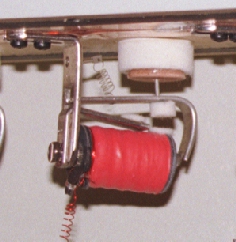

Electro-Mechanical Chests |
Electro-Mechanical Chests | Electric Slider Chests
Electro-Mechanical chests use an electro-magnet to control access of organ wind to the pipes. Typically there are two ways in which this mechanism is applied:
 The strictly electro-mechanical
chest, in which the access of organ wind to each pipe is controlled by an individual
magnet, is
usually associated in the United States with the Direct Electrictm Action patented by the
Wicks Organ Company of Highland, Illinois.
57
In the diagram to the left, an animated drawing shows how their action
works. The black rectangles are a portion of a topboard, and the blue area below
them represents
organ wind. The action consists of a hinged armature (red) with a pallet (magenta)
attached, and
a magnet (green) held in place by a metal frame. As the magnet receives the current
(represented
by a brighter shade of green), it pulls the
armature down, and the pallet is pulled away from the opening in the topboard. Wind
(represented by the
blue arrow) can then exit the chest through the hole that leads to a pipe. When
current is
interrupted to the magnet, it releases the armature, and the pallet closes again.
60
The strictly electro-mechanical
chest, in which the access of organ wind to each pipe is controlled by an individual
magnet, is
usually associated in the United States with the Direct Electrictm Action patented by the
Wicks Organ Company of Highland, Illinois.
57
In the diagram to the left, an animated drawing shows how their action
works. The black rectangles are a portion of a topboard, and the blue area below
them represents
organ wind. The action consists of a hinged armature (red) with a pallet (magenta)
attached, and
a magnet (green) held in place by a metal frame. As the magnet receives the current
(represented
by a brighter shade of green), it pulls the
armature down, and the pallet is pulled away from the opening in the topboard. Wind
(represented by the
blue arrow) can then exit the chest through the hole that leads to a pipe. When
current is
interrupted to the magnet, it releases the armature, and the pallet closes again.
60
 The photograph to the left shows a magnet of the type
illustrated in the diagram above. A film of this
magnet in motion is available. In the film, there is no audio component, because in
order to open the chest and film the magnet in motion, wind pressure had to be
released.
The photograph to the left shows a magnet of the type
illustrated in the diagram above. A film of this
magnet in motion is available. In the film, there is no audio component, because in
order to open the chest and film the magnet in motion, wind pressure had to be
released.
Some browsers will show a set of controls to begin the film. Others will require a
click on the image to start the film. With some browsers, it will be necessary to use
the "back" button to return to this page after viewing the film.
Windchests that use this type of electro-mechanical action are built as single chambers which contain the wind, without channels, chambers, or any other internal partitions. Windchests of this type are referred to in a general sense as "universal" chests, because there is only one space under pressure and its wind is available to all pipes on the chest - - "universally."
 Because there is no further action
required, other than the magnets, pipes can be placed at any point on the surface of
the chest.
The actual shape of the chest, and the pipe placement can be designed to take
advantage of the
available space, even when that space does not have a shape that would permit the
installation of
other types of chests. In the photograph to the right, a wooden Harmonic Flute is
placed on a small offset chest perched on a wall over a somewhat freely arranged vox
humana, making the best possible usage of a limited amount of space.
109
Because there is no further action
required, other than the magnets, pipes can be placed at any point on the surface of
the chest.
The actual shape of the chest, and the pipe placement can be designed to take
advantage of the
available space, even when that space does not have a shape that would permit the
installation of
other types of chests. In the photograph to the right, a wooden Harmonic Flute is
placed on a small offset chest perched on a wall over a somewhat freely arranged vox
humana, making the best possible usage of a limited amount of space.
109
The use of electro-magnets to control directly the access of wind to pipes is also found in a modification of the slider and pallet chest. In chests of this type, the pallet is controlled by an electro-magnet rather than by a mechanical tracker, as in the traditional form of the chest. Chests of this type are fitted with a slider mechanism that may also be controlled by some form of electric action, either a magnet in the form of a solenoid or an electric motor.
© 1998 James H. Cook